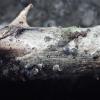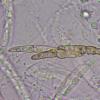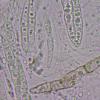
09-11-2025 13:20
Hello.A tiny ascomycete, appearing as erupting gra

08-11-2025 00:29
 Francois Guay
Francois Guay
I found this species in Quebec, Canada, on herbace

04-11-2025 09:07
Hello.A suspected Hymenoscyphus sprouting on a thi

04-11-2025 12:43
 Edvin Johannesen
Edvin Johannesen
Hi! One more found on old Populus tremula log in O

03-11-2025 21:34
 Edvin Johannesen
Edvin Johannesen
These tiny (0.4-0.5 mm diam.), whitish, short-stip
Cf. Paraleptosphaeria
Bernard Declercq,
10-10-2018 19:04
 Hi to all,
Hi to all,Collected on branch of Rosa sp. in Switzerland:
Ascomata erumpent, globose, 0.8-0.9 mm diam., solitary to gregarious, blackish, coriaceous, apically ostiolate, roughened wall, with basal setae and numerous anchoring hyphae.
Asci cylindrical, bitunicate, 8-spored, up to 160x10-12 µm.
Spores fusiform, pointed ends, straight to slightly curved, 36-48x5-6.5(7) µm, 1-septate, slightly constricted at the septum, cell swollen close to the middle septum, guttulate, smooth, hyaline, becoming pale brown, finely verruculose and sometimes 3-septate.
Hamathecium of numerous filiform 1-2 µm diam. pseudoparaphyses.
Peridium with dark brown outer layers and hyaline inner layers of textura angularis.
Your help is welcome.
Bernard Declercq
Mlcoch Patrik,
11-10-2018 11:57

Re : Cf. Paraleptosphaeria
Hi, Bernard,
This is very interesting collection, with Rosa is know only Leptosphaeria hazslinszkii, but it isn´t here. With the genus Paraleptosphaeria this can be only P. praetermissa, which growing on the Rubus and can also growth on another taxa with Rosaceae. Based to morphology of ascospores it belong to Leptosphaeria purpurea group. I don´t have to say, what it is, but I will like take to look on this your collection. Can you send me, please?
This is very interesting collection, with Rosa is know only Leptosphaeria hazslinszkii, but it isn´t here. With the genus Paraleptosphaeria this can be only P. praetermissa, which growing on the Rubus and can also growth on another taxa with Rosaceae. Based to morphology of ascospores it belong to Leptosphaeria purpurea group. I don´t have to say, what it is, but I will like take to look on this your collection. Can you send me, please?




 D-Paraleptosphaeria-sp.-Rosa-sp.-BD-18065-180904-0001.jpg
D-Paraleptosphaeria-sp.-Rosa-sp.-BD-18065-180904-0001.jpg